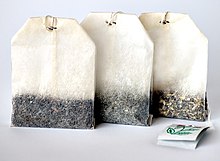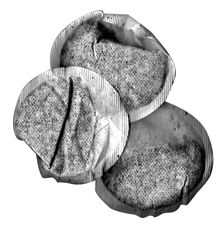Tea bag

A tea bag or teabag is a small, porous, sealed
Tea bags are commonly made of
History
Tea bag patents date from 1903 when Roberta Lawson and Mary McLaren, of Milwaukee, Wisconsin, were granted US patent 723287 for a Tea Leaf Holder, which they had filed in 1901.
The heat-sealed paper fiber tea bag was patented in 1930 by William Hermanson.[6] The now-common rectangular tea bag was not invented until 1944. Prior to that, tea bags resembled small sacks.[7]
Production
Teas
A broad variety of teas as well as other
Shapes and material


Traditionally, tea bags have been square or rectangular in shape. They are usually made of
Tetrahedral tea bags were introduced by the PG Tips brand in 1997.
Empty tea bags are also available for consumers to fill with tea leaves themselves. These are typically open-ended pouches with long flaps. The pouch is filled with an appropriate quantity of leaf tea and the flap is closed into the pouch to retain the tea. Such tea bags combine the ease of use of a commercially produced tea bag with the wider tea choice and better quality control of loose leaf tea.
Plastics
In 2017, Mike Armitage, a gardener in Wrexham, UK, found that tea bags left a plastic residue after being composted. He started a petition urging Unilever to remove plastic from bag production.[14][15][16] In January 2018, Co-op Food announced that they were removing plastic from their own brand 99 tea bags in conjunction with their supplier Typhoo.[17][18] In February 2018, PG Tips announced that their pyramid bags would now use corn starch adhesive in place of polypropylene.[14][19][20]
Microplastics may be found in the tea meant for human consumption. A 2019 study showed that "steeping a single plastic teabag at brewing temperature (95 °C; 203 °F) releases approximately 11.6 billion microplastics and 3.1 billion nanoplastics into a single cup of the beverage".[21][22] A 2021 study analyzed purportedly cellulose tea bags and found that 15 of the 22 bags tested also contained polyester, polyethylene or polypropylene, which are known to shed microplastic fibers.[23][24] Although cellulose is considered to be biodegradable, the plastic components are not and release microplastics to the environment when composted.
Recreational and practical applications
Decorative tea bags have become the basis for large collections and many collectors collect tea bags from around the world. Tea bag collector clubs are widely spread around the world and members consist of people interested in items related to teas. Online collector clubs often include catalogs of tea bags,[25] as well as collection tracking tools. In addition, tea bag collectors often collect other tea-related items such as labels.[26] These websites also provide forums for discussions and trade arrangements between collectors.
Soil scientists used standardized tea bags to measure the decomposition rate of organic materials in different soils.[28][29]
See also

- 3-MCPD, a chemical compound that is carcinogenic, and can occur in some resin-reinforced tea bag materials
- Builder's tea, refers to a basic method of preparing tea in a mug with tea bags
- Melitta 402tea filters
- Tea leaf grading
- Tea strainer, a small mesh utensil that can filter out stray tea leaves when whole-leaf tea is poured from a teapot
- Tetley, the British tea company that introduced tea bags in the United Kingdom in 1953
References
- ^ "Tea-leaf holder". USPTO. Retrieved 25 October 2013. US patent 723287 was issued on MAR. 24, 1903 to R. G.LAWSON & M. McLAREN for a 'novel tea-holding pocket constructed of open-mesh woven fabric, inexpensively made of cotton thread'.
- ^ a b Begley, Sarah (3 September 2015). "The History of the Tea Bag". Time.
- ^ TodayIFoundOut.com, Sarah Stone- (27 April 2015). "How the Tea Bag Was Invented". Gizmodo. Retrieved 2021-06-28.
- )
- ^ Rexing, Bernd (2011-05-14). "14. Mai 1996 - Teebeutel-Entwickler Adolf Rambold stirbt" (in German). Retrieved 2018-08-03.
- ^ Bloxham, Andy (2008-06-13). "Tea bag to celebrate its century". Telegraph.co.uk. Retrieved 2009-07-15.
- ISBN 1607343630
- ^ Fabricant, Florence (2000-02-09). "Whole Leaves, No Strings For a New Tea Bag". The New York Times. Retrieved 2009-07-15.
- ^ Smithers, Rebecca (2 July 2010). "Most UK teabags not fully biodegradable, research reveals". the Guardian.
- ^ "Composting teabags – Which? News". Which? News. 2010-07-02. Retrieved 2018-03-26.
- ^ "PG Tips reclaims number one position with pyramid teabag". Marketing Week. 22 April 1999. Retrieved 4 May 2021.
- ^ "Tea Stick Brewing Package and Method". Freepatentsonline.com. Retrieved 2018-08-16.
- ^ Fabricant, Florence (September 13, 2006). "Tea's Got a Brand New Bag". The New York Times.
- ^ a b "Remove plastics from PG Tips tea bags". Campaigns by You. Retrieved 2018-03-26.
- ^ "Teabags 'a cause of plastic pollution'". BBC News. 2017-12-19. Retrieved 2018-03-26.
- ^ "PG Tips teabags to be made plastic-free". BBC News. 2018-02-28. Retrieved 2018-03-26.
- ^ "The New 'Green' Tea: Co-op Brews Up Solution To Plastic Tea Bags". Retrieved 2018-03-26.
- ^ Smithers, Rebecca (2018-01-28). "An eco-friendly cuppa? Now teabags are set to go plastic-free". the Guardian. Retrieved 2018-03-26.
- ^ "What We're Doing with Our New Decaf Tea Blend – PG tips". PG Tips. Retrieved 2018-03-26.
- ^ Smithers, Rebecca (2018-02-28). "PG tips announces switch to plastic-free fully biodegradable teabags". the Guardian. Retrieved 2018-03-26.
- ^ Chung, Emily (25 September 2019). "Some tea bags may shed billions of microplastics per cup". CBC News. Retrieved 25 September 2019.
- S2CID 202761863.
- S2CID 236273472.
- ^ "Bags of tea are dangerous! Nearly 13,000 microplastic particles detected - Women About". 2022-06-07. Retrieved 2022-06-07.
- ^ "Tea Bags on Colnect". colnect.com. Retrieved 2018-12-18.
- ^ "Tea Labels on Colnect". colnect.com. Retrieved 2019-03-01.
- ^ jbritton (2009-06-29). "Tea bag folding". Britton.disted.camosun.bc.ca. Archived from the original on 2009-08-03. Retrieved 2009-07-15.
- .
- ^ Ogden, Lesley Evans (5 June 2019). "How teabags became a secret weapon in the fight against climate change". New Scientist. Retrieved 31 July 2019.
External links
![]() Media related to Tea bags at Wikimedia Commons
Media related to Tea bags at Wikimedia Commons
